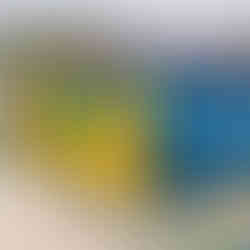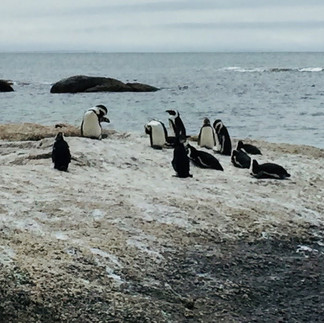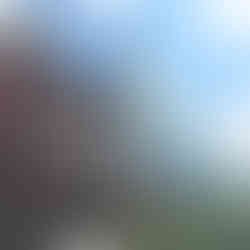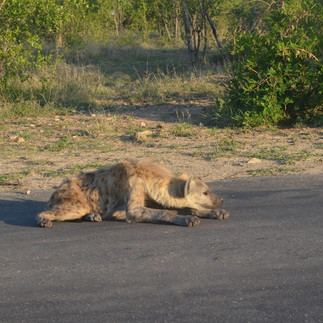South Africa
- fabio pellizzato
- Mar 12, 2023
- 16 min read
Updated: Dec 20, 2024
From Cape Town to Kruger Park and back on the Garden Route. A journey of six thousand kilometers between elephants, ostriches, whales, and white sharks.
☛ MAP TIPS KRUGER PARK SHARK TANK

We have great memories of South Africa, from the color of the oceans to the adrenaline rush of Kruger Park and the Shark tank Adventure.
This post will look back on all the magical moments we experienced in November 2017, so you can relive them with us.
Cape Town
Waterfront, Table Mountain, BO-KAAP, Penguins and vineyards
This was our first intercontinental trip since we've been together.
We book a Rome-Paris-Cape Town flight with Air France for about 500 euros for the month of November, still low season.
We are surprised by how well we travel with this company; the flight offered the main meals in its 11 hours but what struck us was the "open bar", i.e. trolleys with various food including sandwiches, sandwiches, ice cream, snacks, and wine (a lot) that you could freely consume between the various runners across the plane, chatting standing up with the various stewardess and other travelers.
I don't know if we were lucky, but we liked it a lot and it helped to burn off the flight hours!
Once in Cape Town, we are hosted by our friend Kathleen met in Riccione on the beach while she worked as an "au pair girl" for a family we know. With her and her boyfriend, we visit the Victoria and Alfred Waterfront located in the commercial port of Cape Town and we have breakfast in a nice bar also in this area. They provide us with information about the city and areas to avoid because they are dangerous (and they really are), but knowing what they are is enough to stay out of trouble and enjoy this beautiful city. Just take a tour of the trendiest neighborhoods to see armed guards and gates with electric or barbed wire.
An unmissable stop is the BO-KAAP district, a picturesque suburb that makes you feel colorful even inside, where there are many colorful houses in pastel colors and which is located at the foot of Signal Hill in the City Bowl of Cape Town. Its history, sadly, is linked to slavery and it is also known as the 'birthplace of Islam' in the Cape. Enslaved people, artisans, and politicians were brought here from countries such as Africa, India, Sri Lanka, Indonesia, and Malaysia...
The most famous beach and the one with the most exclusive panoramic view at the foot of the Twelve Apostles are called Camps Bay Beach. Here we enjoyed a crystal clear sea, lively beach clubs, and many restaurants, clubs, and various entertainment. In full season it is very crowded but we enjoyed it to the fullest in November!
Finishing talking about beaches, just outside the city, about 15 minutes by car, you can reach Bloubergstrand Beach. This wild beach offers a very beautiful sea, breathtaking villas with private access to the beach, and a very suggestive view of Cape Town, as well as the sunset behind Lion's Head.
An attraction not to be missed, even if you are not a wine lover, are the South African vineyards of Constantia. Elegant lands full of greenery where there is a belief that playing classical music in the vineyards helps to produce a better wine!
Here we arrive by car on a gloomy day and the show was nothing short of amazing. Kilometers and kilometers of verdant vineyards, elegant 19th-century-style buildings where wine is prepared, and places where you can indulge in a tasting. Unbeknownst to us, we discover that the winemaking history of this region begins 350 years ago and still produces fine white and red wines exported all over the world. At the Constantia Glen, we taste the excellent wines and see photos inside the tasting rooms with Queen Elizabeth, American presidents, actors, and well-known personalities who have the best South African wines shipped annually including Merlot, Chenin Blanc, Chardonnay, and Pinotage. In this region, there are also some beautiful wine estates that allow you to stay on their property.
The workhorse of these areas is that being below the equator and therefore with the reverse seasons, it manages to reach the most valuable tables of the North six months earlier than all the others.

You can't get here and not see Table Mountain! To visit it you can pay for a cable car that takes you directly to the top where the view is breathtaking. You see the famous Lion's head and the whole city! In addition, there are several paths, a bar-restaurant, and many panoramic points on the 12 Apostles. Worth every second spent up there.
In the high season, the queue for the cable car is stressful. Furthermore, it must be visited with a clear sky and little wind, otherwise, you will be forced to see the famous "tablecloth" from the ground or the cloud that rests on the flat mountain that acts as a tablecloth...
We made the descent on foot, we don't recommend it unless you are aware of the time and difficulty it takes! The path itself is not difficult but it is steep and the natural steps are very high so it is not a normal walk. Although the landscape was beautiful and an experience I would do it a thousand times again, it was the duty of the lady at the ticket office to warn us of the type of difficulty and by not answering "don't worry, it takes an hour" with a grin on her face .. it took us 3 days later to walk without pain and lactic acid.
It's actually worth it, but be prepared for 3 hours plus of steep downhill walking on uneven steps and blisters everywhere! Having said that, if you are aware it is an experience to do!
Muizenberg Beach is the premier postcard beach for Cape Town. The sand is white and fine and you can often see the horses running freely by the sea, that day we saw two white ones!. What is special about this place are these brightly colored wooden Victorian cabins.
It is located just outside the city and we reached it after having collected our car with a manual transmission on the left and a right-hand drive.
Furthermore, from here you have a panoramic view of the Cape Peninsula it is also renowned for being the most popular beach for surfers.
Still, not far from Muizenberg Beach, we reach Simon's Town and the "penguin beach" located on the shores of False Bay.
One of the main attractions of Simon's Town is certainly the famous Boulders Beach, located a few kilometers south of the town, towards Cape Point.
It is one of the most popular beaches and since 1982 it has hosted a colony of about 2,500 African penguins, also called black-footed penguins or jackass penguins (donkey), due to their sound resembling the braying of a donkey. If you're lucky, you'll find them walking next to you...
Cape of Good Hope
The southern most point of the African continent
The Cape of Good Hope is the southern tip of the Cape Peninsula. It is mistakenly considered the southernmost point of Africa and a point of separation between the Atlantic Ocean and the Indian Ocean, but in reality, this belongs to Cape Agulhas, which we will discuss later.
Upon our arrival, the day always welcomes us gloomily, but this only increases the suggestiveness of this place.
The Cape of Good Hope is essentially made up of a pebble beach and cliffs overlooking the sea, the ones we like.
Continuing north, we find the highest point of Cape Point, and indulge in a meal at Two Oceans Restaurant, before visiting two lighthouses.
The oldest lighthouse was active from 1860 to 1919 and today, the whole area of the Cape of Good Hope and Cape Point is inhabited by large communities of baboons (which we have not seen).
And the real end of Africa
A stop not to be missed is Cape Agulhas, the true southern end of the African continent. This is where the Atlantic and Indian Oceans meet. The colors all around are wonderful, both of the sea and of the vegetation. At the foot of the beach, there is a stone bearing the inscription of the geographical position.
This area is part of the Agulhas National Park and hosts a small penguin hospital that we visited and wanted to support with the entrance ticket.
We also recommend visiting in Cape Town:
- Lion's Head
- Signal Hill where you can lie down to look at the view and the stars
- Clifton Beach
- the Downtown area and the park around Government Ave
- The Old Biscuit Mill for Saturday nights
- Robin Island Museum and Nelson Mandela prison
The N1 highway and the 1,400km to Johannesburg
Johannesburg
We leave Cape Town with regret and with our car we head towards Kruger Park not going along the mythical Garden Route on the coast but opting for the main internal route. This option of not doing the Garden Route right away but doing it on the way back was due to the bad weather that we wanted to avoid.. we managed to bring rain and snow even here where there was drought XD
The road to Johannesburg is approximately 1,400km long and travels through valleys, grasslands, and semi-deserts with extreme temperatures passing through Beaufort West and Colesberg. Along this stretch, we stop at a very nice little place recommended by our portable guide called The Richmond Café and Rooms in the village of Richmond. Here we are greeted by a young and kind black girl who prepares us a homemade ginger drink and brings us a slice of cake to eat. Both are delicious as the guide suggested! Along the way, shortly after, we made another stop at the dam .. just to change the landscape from the monotony of the desert.
The road turns out to be terribly straight and sometimes monotonous and before arriving at the first place to stay overnight, darkness arrives and we encounter a kind of hurricane with a very strong side wind. I drove all day into the night for 1,000km battling this downpour and the trucks spraying water from under the wheels like a fire hydrant. We finally arrive at our B&B in Bloemfontein where this thriving gentleman hosted us and tells us that it has also snowed not far away... Before going to bed we went to eat two nice steaks and two beers not far from home, then finally we go to rest as it should be!
The next day we visit Johannesburg quickly and then arrive directly at the Park near the Kruger. As has already happened, here too, once parked, someone asks if they can look at the car in exchange for some Zar (local currency). Johannesburg had previously been described to us as a dangerous city, but we didn't find any particular difficulties. The ride was quite fast, with some central neighborhoods but nothing impressive.. it was nice to see that here the black part of the population was not placed on the edge of the city as in other cases.
Kruger Park
Back to nature
Finally, here we are, in the deepest spirit of Africa, in one of the most famous parks in the world also by extension.
We did not stay inside the park even if we later regretted it because they organize night safaris in search of rarer animals that hide in the shade during the day due to the heat. It was not easy to find information on the internet on your own about the park and internal accommodation, because often it is the agencies who organize them. However, we had bought a pass for all the South African parks online because with the package we saved the various entrance costs, but in the end, we only visited that one, which was enough.
Kruger National Park is one of Africa's largest wildlife reserves. It extends for 20,000 km2 between South Africa, Zimbabwe, Mozambique, and Swaziland and has been designated by UNESCO as an International Man and Biosphere Reserve.
Its particular density of wildlife includes the Big Five: lion, leopard, rhino, elephant, and buffalo. We saw 4 of the Big Five and were missing the lion. We wandered endlessly, we heard their roars but unfortunately, they were always hidden.
Hundreds more other mammals and several bird species make their homes here such as vultures, eagles, and storks. The landscape includes mountains, scrub plains, and tropical forests. During our stay, we saw several fires develop and several workers at work tame them even though it was still November!
Here we had close encounters with endless elephants, hyenas, giraffes, leopards sleeping in trees, antelopes, crocodiles, kudus, impalas, rhinos, hippos and so much more that popped up in every part of the park. We also managed to see puppies of many species, being a suitable period. The sunsets have been the master of one of the most beautiful experiences that can be lived and that we will hardly forget!!!
Returning to the accommodation, we stayed in a beautiful safari park adjacent to the Kruger, with an outdoor jacuzzi, an outdoor bathtub, and an obviously modernized typical South African structure. The room was an independent house among the others and was inside the natural park. It wasn't difficult to make too close encounters at night with kudu and other animals and the owner, who looked like the one from Jurassic Park, had warned us that the lions could be heard nearby the previous morning! We dined and drank on our outside sofas, at night, with arm hair on end and eyes always wandering around in the dark and ready to flee at the first sound!
Blyde River Canyon Reserve Park
After about three days in the park, we reluctantly leave this place that has entered deep within us and reach another stage: God's Window and the Blyde River Canyon, the third largest canyon in the world. Here we park the car and enter this natural park to admire the famous terrace with a view as far as the eye can see.
Also around the Canyon, you can visit a waterfall called Lone Creek Falls, where together with some Spanish or Portuguese boys (I'm going by memory) we climbed over a fence to get right above the waterfall.
Toward to the sea to Port Elisabeth
Garden Route
Before heading to Port Elizabeth, the guide suggested making a stop in a village along the way (actually there was a half-hour detour) famous for having remained frozen in the 1800s. The houses originate from the 1800s and keep their shapes and colors unchanged, on the street we also see people and children going to school dressed as they were at the time! Unfortunately, we don't remember the name and we haven't saved it on the map.
After visiting this village for about an hour, we set our wheels towards Port Elizabeth, where we booked a night in a hotel with a garden and swimming pool. In the evening we decide to take a stroll on the sea, we take a stroll at the port and among the various streets in the center. Since the exchange was convenient and therefore the prices, in general, were lower for a European, we arrive at this beautiful restaurant called Blue Waters Cafè on the port, to eat some excellent fish accompanied by a bottle of white wine. When we parked the car, a black lady asked us if she could look after it and to avoid problems we agreed.
The next morning we head back towards Cape Town but this time through the Garden Route, one of the most beautiful coastal roads in the world!
Along the way we pass through a very famous bridge that joins two Canyons (Eastern Cape with Western Cape), called Bloukrans Bridge, where they bungee jump and around there are forests to visit, parks, and activities including kayaking that we love. Unfortunately, we are just passing through and we stop for a drink and then leave.
The next stop is Plettenberg Bay which is today one of the main tourist spots along the Garden Route and is located in the middle of a dozen nature reserves and parks (including the Robberg Peninsula reserve and the Tsitsikamma park). Here in the area, there is one of the highest bungee jumps in the world (216m) on the Bloukrans River. Like other bays on the south coast, it is home to southern right whales from July to December.
In addition, the view of the ocean here too is spectacular, from the crystal clear to the deep blue that surrounds the foaming waves.

Knysna and Brenton Beach
Looking for whales
Knysna, a South African coastal city overlooking the Indian Ocean, is an important tourist destination; due to the extremely mild climate and it is also one of the places where elderly South Africans like to retire. Knysna is also the terminus of the Outeniqua Choo Tjoe scenic steam train line.
Here we bought tickets for whale watching with a speedboat. Initially, once we went out to sea, we were accompanied by a pod of dolphins that were constantly jumping around us.
Further on, we sighted some whales and were told it was a family with a "little one". Spotting them is not easy, you have to sharpen your eyes and recognize the spray emanating from the blowhole which, however, is often confused with the waves of the sea.
Here in Knysna the sea and the rugged coast were once also famous for their mortality, several weighmen have lost their lives in the past due to the strong currents and the presence of rocks called Knysna Heads which protect the bay but also make the waters treacherous.

Next to Knysna, we stop at Brenton Beach, a beach with golden sand and blue sea. The high waves are the masters and we decide to stop to spend a few hours on the beach. We try to swim but it's frozen and the waves don't inspire us to go any further.
There are several rocks on the beach and we hide from the wind behind one of those to sunbathe with the occasional walk up and down.
To this day it remains one of the most beautiful beaches in South Africa that we have seen: a mandatory stop!
Also in the afternoon we also visited Wilderness beach.

Oudtshoorn
The Ostrich Capital of the world
We always read in the guide that nearby Oudtshoorn is famous for its ostriches: there are farms with ostriches that you can visit and so we decide to see this too, so as not to miss anything!
Immediately in the city, we find women along the roadside selling colorful ostrich feathers as decorations for the home or as feather dusters for cleaning. We follow a barren red-earth road that looks a bit like Texan roads and we arrive at one of the farms.
We pay the ticket to enter and discover that you can ride ostriches! Why not try? And so we climb over the fence to find ourselves a few steps away from the ostriches. An attendant approaches the animal, stretching towards the neck and then lowering it to the ground and inserting a cloth bag so that it cannot see and start running. A strange but amusing scene in our eyes, and they assure us that the animal is not suffering.
At this point, we climb on the back while two other operators open the "wings" which will then rest on our legs. Finally, the attendant takes off the bag and the ostrich ... he starts to run! Seeing the two of us on the animal's back makes us burst out laughing. This ostrich really runs like crazy and it's hilarious!
In Oudtshoorn, ostrich races are also held (a practice that is no longer legal in some states), which can reach an average speed of 50-60 km/h with peaks of up to 70 km/h.

Mossel baai
Hiking by the sea
At Mossel baai we stopped for the night and visited the seaside town.
Starting from the car park in front of the lighthouse, you enter a prehistoric cave where the first human remains were found and where excavations are still going on today. Unfortunately, the cave was closed that day otherwise we would have visited it for sure.
Here, next to the cave, a panoramic route called the Saint Blaize Hiking trail begins, which runs along the rocks overhanging the sea. The route is safe, not difficult to do, and guarantees a spectacular view of the ocean flanked by grass, rocks, flowers, and lots of other vegetation! If you are lucky and have binoculars, you may spot whales.

Sand dunes
De Hoop
De Hoop Nature Reserve is a protected area and the southernmost nature reserve in Africa. It belongs to the Cape Floristic Region and has been a UNESCO World Heritage Site since 2004.
They are located on a stretch of coast characterized by huge and expansive white sand dunes in the western part and rocky bays framed by cliffs in the eastern one.
We are towards the end of the journey and we discovered this nature reserve by chance. We were thrilled because the clear sky and little wind allowed us to photograph this wonderful scenery, climb the dunes and roll all the way like children! In our opinion, this is also a mandatory stop!
Gansbaai
And the shark tank!
Also from Italy, we wanted to book an activity that once in a lifetime had to be done: the Shark Tank! Since the parachute jump in Cape Town had been canceled by the wind, at least this seemed safe until the day before, and it was.
The appointment was early in the morning and they would have picked us up directly at the hotel, which was beautiful but we were not able to enjoy it because we arrived late the night before and the next day we would have an appointment very early.
Once we arrive at the place, a boy makes us put on our wetsuits and explains how the morning would be organized. We would all get on the boat, the cage would be lowered into the sea and in groups of 3-4 people we would lower ourselves inside while the boy from the ship would attract the sharks with a tuna head attached to the rod.
The morning continues as per the textbook and the first medium-sized shark arrives, the white shark hasn't been seen for several months, they tell us. They ask us who they wanted to be the first to climb and I wanted to wait, after a sleepless night because I was feeling a bit nervous XD.
After a while, having ascertained that the shark was harmless, Federica and I decide to dive into the cage too! Excellent timing because at that very moment, a 4.5-meter male white shark was attracted, and he was there in front of us as we hear the cage close above us.....
Adrenaline takes the place of fear and we find ourselves face to face, inches from the gaping mouth full of sharp teeth that bangs against the cage and then disappears into the depths to suddenly return and always tail against the cage.
I think I will never, ever forget this experience!!! I wanted to do it 100 more times and luckily the guy got us a couple of "rounds" each.
They also release us the paid video that an employee shoots for everyone. A difficult part of the experience is staying many hours on the boat watching the sharks in the sea, Federica had nausea for a whole day .. she was better in the cage!

Cape Town
Last stop
With sadness filling our bodies, we return to Cape Town to conclude our last days. We deliver the car and while waiting in line with the other delivery cars we notice that many have suffered damage, especially to the windows, which makes us think of some criminal who attacked the car, especially when stopped at traffic lights. We've already read about this danger in South Africa, but luckily everything went really well for us.. we didn't even get flat tires as we saw happen to many along the way. It's always better to insure your car fully in these places.
Last Belgian beer at the port and then off to the airport to return home.
Useful tips:
Budget: we spent about 1,650 euros each. An agency had offered two of our friends almost the same tour for figures that were around 5/6 thousand euros.
Km traveled: about 6,000. We recommend a slightly higher category car for long-haul transfers such as Cape Town - Kruger Park not for speed but for comfort or a domestic flight. Once upon a time in Italy, we kept getting fines for speeding, about a dozen but with very low prices (about 20-22 euros per fine). Pay attention to speed cameras, especially when entering inhabited areas.
Must places:
Cape Town and Table Mountain, Cape of Good Hope, Kysna, Kruger Park
Map:
Click here to see the map and use it during the trip









































































































Comments